#koliva
Explore tagged Tumblr posts
Text
Today we had yearly memorial of my grandfather and we got A LOT of kolyva remaining. Who wants some?

#orthodox christianity#christianity#jesus christ#christian faith#christian#church#jesus#greek orthodox#orthodox#orthodoxy#eastern orthodox#koliva
3 notes
·
View notes
Text

Koliva with the icon of Hieromartyr Anthimus the Georgian at the patronal feast of Bucharest’s Anthimus Monastery on September 27, 2023. Photo credit: Basilica.ro / Mircea Florescu
4 notes
·
View notes
Text
youtube
kafamın içindeki müzik kutusunda bugün çalan ..
2 notes
·
View notes
Text
Name one thing about Greeks that would send white people into a coma I'll go first
κολυβα (koliva)
It's a wheet grain, honey, pomegranate, and nut mix with baked flour mixed with sugar on top.
It's eaten when someone you know dies and has a cross made of any ingredient on top and it's fuckin delicious
1 note
·
View note
Text
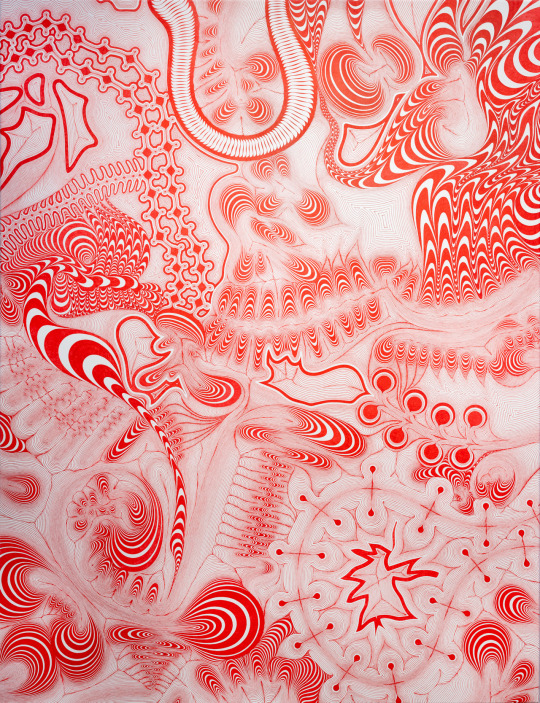
Mauro Ariel Koliva - BRANDA-MEL (tinta sobre tela), 2022
6K notes
·
View notes
Text

Mauro Ariel Koliva — Secret Matter (gel ink on canvas, 2021)
1K notes
·
View notes
Text



"MAGKROK" by Mauro Ariel Koliva, 2024. ~ detail 2 ~ detail 1 ~ whole painting Argentinian artist (and musician), born 1977.
51 notes
·
View notes
Text
Khytrai, huh. I did manage to prep my koliva last night, as offering to Hermes Kthonios and the beloved dead. I also attended a vigil for Nex Benedict organized by a local high school GSA tonight. Feeling some big things about that falling on this day. The NB flag and the candle I received there ended up on my altar. Tell your trans friends you love them.
#i wish i had more to say that didn't feel contrived. death is real. yknow?#txt#rl#anthesteria#as always i have way too much koliva due to. water makes grains expand dumbass. and i don't really enjoy eating it all that much. but. well#it's breakfast now i guess.
7 notes
·
View notes
Text
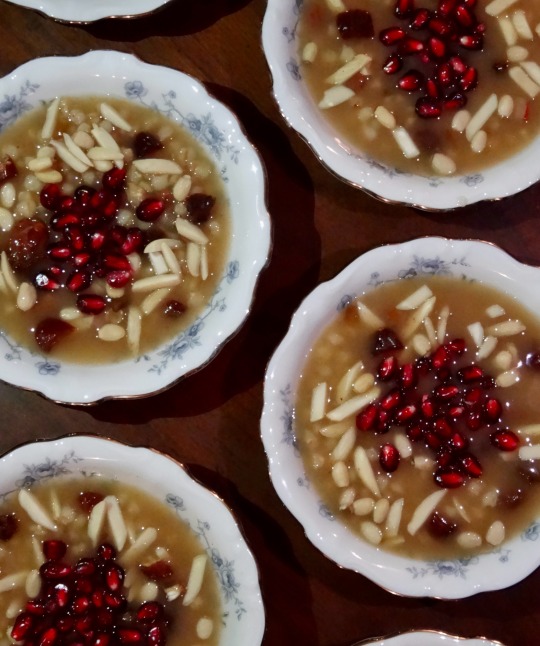
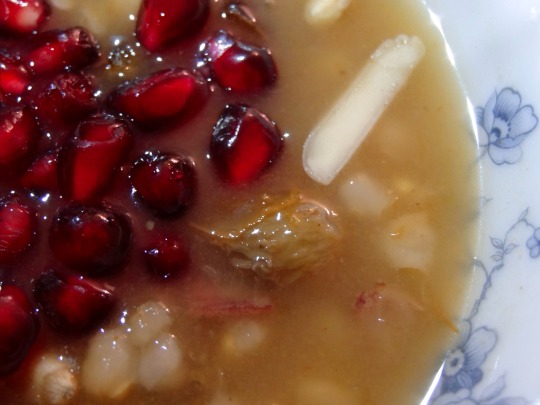
[ID: First image shows four small porcelain bowls of a pudding topped with slivered almonds and pomegranates seeds, seen from above. Second image is an extreme close-up showing the blue floral pattern on the china, slivered almonds, golden raisins, and pomegranate seeds on top of part of the pudding. End ID]
անուշապուր / Anush apur (Armenian wheat dessert)
Anush apur is a sweet boiled wheat pudding, enriched with nuts and dried fruits, that is eaten by Armenians to celebrate special occasions. One legend associates the dish with Noah's Ark: standing on Mt. Ararat (Արարատ լեռը) and seeing the rainbow of God's covenant with humanity, Noah wished to celebrate, and called for a stew to be prepared; because the Ark's stores were diminishing, the stew had to be made with small amounts of many different ingredients.
The consumption of boiled grains is of ancient origin throughout the Levant and elsewhere in West Asia, and so variations of this dish are widespread. The Armenian term is from "անուշ" ("anush") "sweet" + "ապուր" ("apur") "soup," but closely related dishes (or, arguably, versions of the same dish) have many different, overlapping names.
In Arabic, an enriched wheat pudding may be known as "سْنَينِيّ��" ("snaynīyya"), presumably from "سِنّ" "sinn" "tooth" and related to the tradition of serving it on the occasion of an infant's teething; "قَمْح مَسْلُوق" ("qamḥ masluq"), "boiled wheat"; or "سَلِيقَة" ("salīqa") or "سَلِيقَة القَمْح" ("salīqa al-qamḥ"), "stew" or "wheat stew," from "سَلَقَ" "salaqa" "to boil." Though these dishes are often related to celebrations and happy occasions, in some places they retain an ancient association with death and funerary rites: qamh masluq is often served at funerals in the Christian town of بَيْت جَالَا ("bayt jālā," Beit Jala, near Bethlehem).
A Lebanese iteration, often made with milk rather than water, is known as "قَمْحِيَّة" ("qamḥīyya," from "qamḥ" "wheat" + "ـِيَّة" "iyya," noun suffix).
A similar dish is known as "بُرْبَارَة" ("burbāra") by Palestinian and Jordanian Christians when eaten to celebrate the feast of Saint Barbara, which falls on the 4th of December (compare Greek "βαρβάρα" "varvára"). It may be garnished with sugar-coated chickpeas and small, brightly colored fennel candies in addition to the expected dried fruits and nuts.
In Turkish it is "aşure," from the Arabic "عَاشُوْرَاء" ("'āshūrā"), itself from "عَاشِر" ("'āshir") "tenth"—because it is often served on the tenth day of the month of ٱلْمُحَرَّم ("muḥarram"), to commemorate Gabriel's teaching Adam and Eve how to farm wheat; Noah's disembarkment from the Ark; Moses' parting of the Red Sea; and the killing of the prophet الْحُسَيْن بْنِ عَلِي (Husayn ibn 'Ali), all of which took place on this day in the Islamic calendar. Here it also includes various types of beans and chickpeas. There is also "diş buğdayı," "tooth wheat" (compare "snayniyya").
These dishes, as well as slight variations in add-ins, have varying consistencies. At one extreme, koliva (Greek: "κόλλυβα"; Serbian: "Кољиво"; Bulgarian: "Кутя"; Romanian: "colivă"; Georgian: "კოლიო") is made from wheat that has been boiled and then strained to remove the boiling water; at the other, Armenian anush apur is usually made thin, and cools to a jelly-like consistency.
Anush apur is eaten to celebrate occasions including New Year's Eve, Easter, and Christmas. In Palestine, Christmas is celebrated by members of the Armenian Apostolic church from the evening of December 24th to the day of December 25th by the old Julian calendar (January 6th–7th, according to the new Gregorian calendar); Armenian Catholics celebrate on December 24th and 25th by the Gregorian calendar. Families will make large batches of anush apur and exchange bowls with their neighbors and friends.
The history of Armenians in Palestine is deeply interwoven with the history of Palestinian Christianity. Armenian Christian pilgrimages to holy sites in Palestine date back to the 4th century A.D., and permanent Armenian monastic communities have existed in Jerusalem since the 6th century. This enduring presence, bolstered by subsequent waves of immigration which have increased and changed the character of the Armenian population in Palestine in the intervening centuries, has produced a rich history of mutual influence between Armenian and Palestinian food cultures.
In the centuries following the establishment of the monasteries, communities of Armenian laypeople arose and grew, centered around Jerusalem's Վանք Հայոց Սրբոց Յակոբեանց ("vank hayots surbots yakobeants"; Monastery of St. James) (Arabic: دَيْر مَار يَعْقُوب "dayr mār ya'qūb"). Some of these laypeople were descended from the earlier pilgrims. By the end of the 11th century, what is now called the Armenian Quarter—an area covering about a sixth of the Old City of Jerusalem, to the southwest—had largely attained its present boundaries.
Throughout the 16th and 17th centuries, the Patriarchate in Jerusalem came to have direct administrative authority over Armenian Christians across Palestine, Lebanon, Egypt, and Cyprus, and was an important figure in Christian leadership and management of holy sites in Jerusalem (alongside the Greek Orthodox and Roman Catholic churches). By the middle of the 19th century, a small population of Armenian Catholics had joined the larger Armenian Apostolic community as permanent residents in Jerusalem, living throughout the Muslim Quarter (but mostly in a concentrated enclave in the southwest); in the beginning of the 20th century, there were between 2,000 and 3,000 Armenians of both churches in Palestine, a plurality of whom (1,200) lived in Jerusalem.
The Turkish genocide of Armenians beginning in 1915 caused significant increases in the populations of Armenian enclaves in Palestine. The Armenian population in Jerusalem grew from 1,500 to 5,000 between the years of 1918 and 1922; over the next 3 years, the total number of Armenians in Palestine (according to Patriarchate data) would grow to 15,000. More than 800 children were taken into Armenian orphanages in Jerusalem; students from the destroyed Չարխափան Սուրբ Աստվածածին վանք (Charkhapan Surb Astvatsatsin Monastery) and theological seminary in Armash, Armenia were brought to the Jerusalem Seminary. The population of Armenian Catholics in the Muslim Quarter also increased during the first half of the 20th century as immigrants from Cilicia and elsewhere arrived.
The immediate importance of feeding and housing the refugees despite a new lack of donations from Armenian pilgrims, who had stopped coming during WW1—as well as the fact that the established Armenian-Palestinians were now outnumbered by recent immigrants who largely did not share their reformist views—disrupted efforts on the part of lay communities and some priests to give Armenian laypeople a say in church governance.
The British Mandate, under which Britain assumed political and military control of Palestine from 1923–1948, would further decrease the Armenian lay community's voice in Jerusalem (removing, for example, their say in elections of new church Patriarchs). The British knew that the indigenous population would be easier to control if they were politically and socially divided into their separate religious groups and subjected to the authority of their various religious hierarchies, rather than having direct political representation in government; they also took advantage of the fact that the ecclesiastical orders of several Palestinian Christian sects (including the Armenian Patriarchate of Jerusalem) comprised people from outside of Palestine, who identified with religious hierarchy and the British authorities more than they identified with the Palestinian lay communities.
British policy, as well as alienating Armenians from politics affecting their communities, isolated them from Arab Palestinians. Though the previously extant Armenian community (called "քաղաքացի" "kaghakatsi," "city-dwellers") were thoroughly integrated with the Arab Palestinians in the 1920s, speaking Arabic and Arabic-accented Armenian and eating Palestinian foods, the newer arrivals (called "زُوَّار" / "զուվվար" "zuwwar," "visitors") were unfamiliar with Palestinian cuisine and customs, and spoke only Armenian and/or Turkish. Thus British policies, which differentiated people based on status as "Arab" (Muslim and Christian) versus "Jewish," left new Armenian immigrants, who did not identify as Arab, disconnected from the issues that concerned most Palestinians. They were predominantly interested in preserving Armenian culture, and more concerned with the politics of the Armenian diaspora than with local ones.
Despite these challenges, the Armenian Patriarchate of Jerusalem came to be a vital center of religious and secular culture for the Armenian diaspora during the British Mandate years. In 1929, Patriarch Yeghishe Turian reëstablished the Սուրբ Յակոբեանց Տպարան ("surbots yakobeants taparan"; St. James printing house); the Patriarchate housed important archives relating to the history of the Armenian people; pilgrimages of Armenians from Syria, Lebanon, and Egypt increased and the economy improved, attracting Armenian immigrants in higher numbers; Armenians held secular roles in governance, policing, and business, and founded social, religious, and educational organizations and institutions; Armenians in the Old and New Cities of Jerusalem were able to send financial aid to Armenian victims of a 1933 earthquake in Beirut, and to Armenians expelled in 1939 when Turkey annexed Alexandretta.
The situation would decline rapidly after the 1947 UN partition resolution gave Zionists tacit permission to expel Palestinians from broad swathes of Palestine. Jerusalem, intended by the plan to be a "corpus separatum" under international administration, was in fact subjected to a months-long war that ended with its being divided into western (Israeli) and eastern (Palestinian) sections. The Armenian population of Palestine began to decline; already, 1947 saw 1,500 Armenians resettled in Soviet Armenia. The Armenian populations in Yafa and Haifa would fall yet more significantly.
Still, the Armenian Patriarchate of Jerusalem maintained its role as the center of Armenian life in Palestine; the compound provided food and shelter to thousands of Armenians during the Battle for Jerusalem and the Nakba (which began in 1948). Some Armenians formed a militia to defend the Armenian Quarter against Haganah shelling during the battle.
In the following years, historical British contributions to the shoring up of insular power in the Patriarchate would cause new problems. The Armenian secular community, no longer empowered to oversee the internal workings of the Patriarchate, could do nothing to prevent embezzling, corruption, and even the sale of church-owned land and buildings to settlers.
In 1967, Israeli military forces annexed East Jerusalem, causing another, albeit smaller, surge in Armenian emigration from the city. Daphne Tsimhoni estimates based on various censuses that the Armenian population of Jerusalem, which had reached 5,000-7,000 at its peak in 1945–6, had fallen back to 1,200 by 1978.
Today, as in the 20th century, Armenians in Jerusalem (who made up nearly 90% of the Armenian population of Palestine as of 1972) are known for the insularity of their community, and for their skill at various crafts. Armenian food culture has been kept alive and well-defined by successive waves of immigrants. As of 2017, the Armenian Patriarchate supplied about 120 people a day with Armenian dishes, including Ղափամա / غاباما "ghapama" (pumpkin stuffed with rice and dried fruits), թոփիկ / توبيك "topig" (chickpea-and-potato dough stuffed with an onion, nut, fruit, and herb filling, often eaten during Lent), and Իչ / ايتش "eetch" (bulgur salad with tomatoes and herbs).
Restaurants lining the streets of the Armenian and Christian quarters serve a mixture of Armenian and Palestinian food. Լահմաջո "lahmadjoun" (meat-topped flatbread), and հարիսա / هريس "harisa" (stew with wheat and lamb) are served alongside ֆալաֆել / فلافل ("falafel") and մուսախան / مسخن ("musakhkhan"). One such restaurant, Taboon Wine Bar, was the site of a settler attack on Armenian diners in January 2023.
Up until 2023, despite fluctuations in population, the Armenian community in Jerusalem had been relatively stable when compared to other Armenian communities and to other quarters of the Old City; the Armenian Quarter had not been subjected to the development projects to which other quarters had been subjected. However, a deal which the Armenian Patriarchate had secretly and unilaterally made with Israel real estate developer Danny Rotham in 2021 to lease land and buildings (including family homes) in the Quarter led Jordan and Palestine to suspend their recognition of the Patriarch in May of 2023.
On 26th October, the Patriarchate announced that it was cancelling the leasing deal. Later the same day, Israeli bulldozers tore up pavement and part of a wall in حديقة البقر ("ḥadīqa al-baqar"; Cows' Garden; Armenian: "Կովերի այգու"), the planned site of a new luxury hotel. On 5th November, Rothman and other representatives of Xana Gardens arrived with 15 settlers—some of them with guns and attack dogs—and told local Armenians to leave. About 200 Armenian Palestinians arrived and forced the settlers to stand down.
On 12th and 13th November, the developer again arrived with bulldozers and attempted to continue demolition. In response, Armenian Palestinians have executed constant sit-ins, faced off against bulldozers, and set up barricades to prevent further destruction. The Israeli occupation police backed settlers on another incursion on 15th November, ordering Armenian residents to vacate the land and arresting three.
On December 28th, a group of Armenian bishops, priests, deacons, and seminary students (including Bishop Koryoun Baghdasaryan, the director of the Patriarchate's real estate department) were attacked by a group of more than 30 people armed with sticks and tear gas. The Patriarchate attributed this attack to Israeli real estate interests trying to intimidate the Patriarchate into abandoning their attempt to reverse the lease through the court system. Meanwhile, anti-Armenian hate crimes (including spitting on priests) had noticeably increased for the year of 2023.
These events in Palestine come immediately after the ethnic cleansing of Լեռնային Ղարաբաղ ("Lernayin Gharabagh"; Nagorno-Karabakh); Israel supplied exploding drones, long-range missiles, and rocket launchers to help Azerbaijan force nearly 120,000 Armenians out of the historically Armenian territory in September of 2023 (Azerbaijan receives about 70% of its weapons from Israel, and supplies about 40% of Israel's oil).
Support Palestinian resistance by donating to Palestine Action’s bail fund; buying an e-sim for distribution in Gaza; or donating to help a family leave Gaza.
Ingredients
180g (1 cup) pearled wheat (قمح مقشور / խոշոր ձաւար), soaked overnight
3 cups water
180-360g (a scant cup - 1 3/4 cup) sugar, or to taste
Honey or agave nectar (optional)
1 cup total diced dried apricots, prunes, golden raisins, dried figs
1 cup total chopped walnuts, almonds, pistachios
1 tsp rosewater (optional)
Ceylon cinnamon (դարչին) or cassia cinnamon (կասիա)
Aniseed (անիսոն) (optional)
Large pinch of salt
Pomegranate seeds, to top (optional)
A Palestinian version of this dish may add pine nuts and ground fennel.
Pearled wheat is whole wheat berry that has gone through a "pearling" process to remove the bran. It can be found sold as "pearled wheat" or "haleem wheat" in a halal grocery store, or a store specializing in South Asian produce.
Amounts of sugar called for in Armenian recipes range from none (honey is stirred into the dish after cooking) to twice the amount of wheat by weight. If you want to add less sugar than is called for here, cook down to a thicker consistency than called for (as the sugar will not be able to thicken the pudding as much).
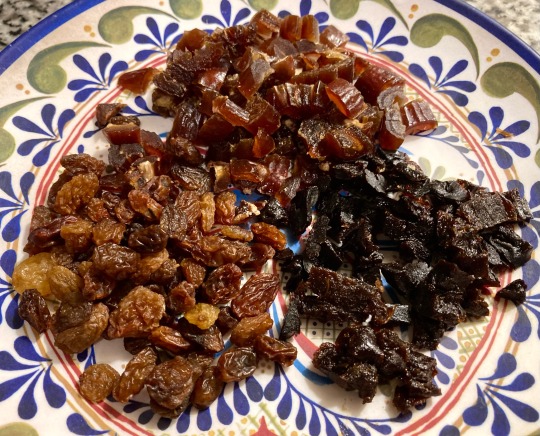
Instructions
1. Submerge wheat in water and scrub between your hands to clean and remove excess starch. Drain and cover by a couple inches with hot water. Cover and leave overnight.
2. Drain wheat and add to a large pot. Add water to cover and simmer for about 30 minutes until softened, stirring and adding more hot water as necessary.
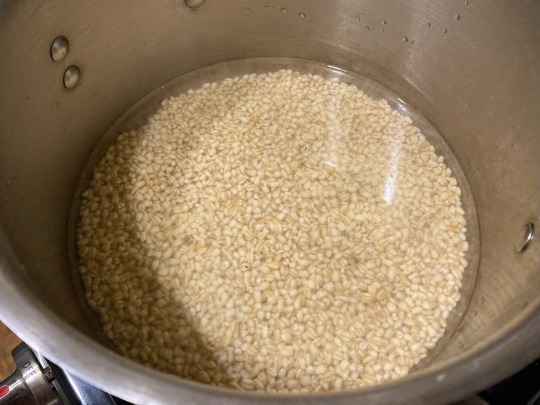
Wheat before cooking
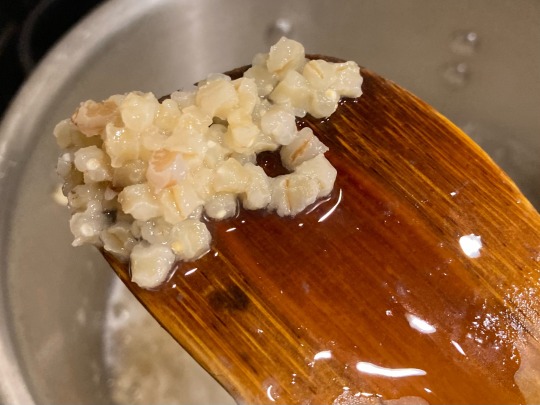
Wheat after cooking
3. Add dried fruit, sugar, salt, and spices and simmer for another 30 minutes, stirring occasionally, until wheat is very tender. Add water as necessary; the pudding should be relatively thin, but still able to coat the back of a spoon.
4. Remove from heat and stir in rosewater and honey. Ladle pudding into individual serving bowls and let cool in the refrigerator. Serve cold decorated with nuts and pomegranate seeds.
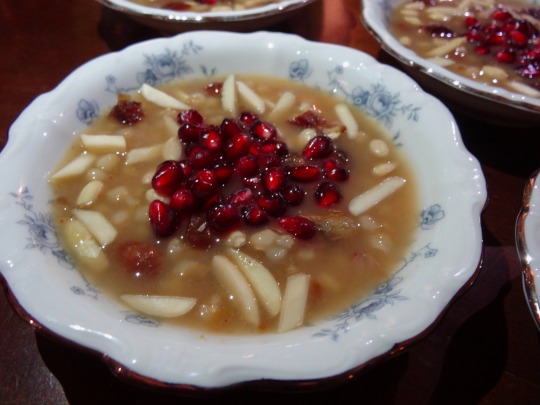
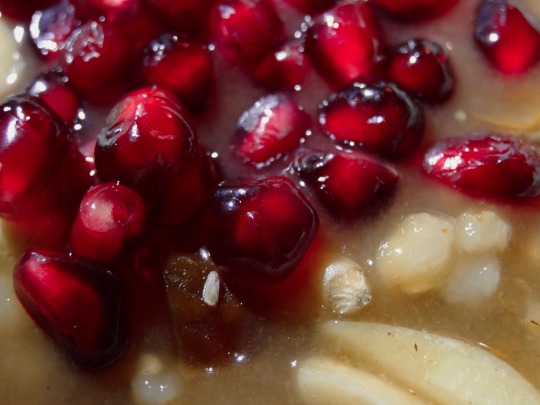
#the last link is a different / new fundraiser#Armenian#Palestinian#fusion#wheat berries#pearled wheats#pomegranate#prunes#dried apricot#dates#long post /
376 notes
·
View notes
Text
Fun fact: pomegranate has continued to be associated with death in greek culture even now in modern times. We have a desert called "koliva" that has existed since ancient times that we serve at funerals and memorials, and pomegranate is one of the main ingredients. It symbolizes the soul of the dead and the glory of heaven.
#other orthodox christian countries have the same tradition#all 9 of its ingredients symbolize something#and it tastes so good#text#crispy#random knowledge#greece#ancient greece#greek culture
45 notes
·
View notes
Note
what are ways to connect with hermes as a psychopomp/chthonic deity? aside from like when an actual death occurs. im realizing i never really have, but id like to!
Hey, Nonny, great question! I don't often see interest in this topic.
A big part of honoring Hermes' Chthonic aspects, from what I have seen, has actually been honoring the dead themselves. During the celebration of the last day of Anthesteria, for example, offerings were given to both Hermes and the souls of the dead, honoring them alongside each other. A specific food offering, called koliva, was given on that day.
With this knowledge, a good way to honor Hermes Chthonios/Psychopompos would be honoring the dead. Doing such things as visiting a loved one's grave, leaving flowers at graves (with permission, of course), and even interacting with ancestors can be ways of connecting with him more. I think another great way of devoting to him is showing kindness and respect to your fellow human. While this can be for Ouranic Hermes as well, I think having compassion to others (not at the expense of yourself) is still a great devotional act to Chthonic Hermes. As a Psychopomp, I'd have to imagine he has to be pretty compassionate towards the souls of the dead to effectively do his job. I'm sure he's helped terrified souls, furious souls, and confused souls cross the threshold into the afterlife, so practicing that same kindness towards others in your life is a great devotional act. Help life be easier and more enjoyable for one another. :) Simply working to enjoy your life can also be good. Trying things you've always wanted to try, engaging in activities that make you happy, volunteering for causes you care about - such activities could all be dedicated to him. Enjoying the life you currently have is an underrated form of devotion, in my opinion, and it's something I've found Hermes likes a lot (he's even actively helping me with it).
Something I like to do to as well is engage with media that discusses death. Two movies I recommend watching with Hermes Chthonios would be Puss in Boots & The Last Wish and Coco (I know Coco is a different culture, but the way it approaches the topic of death is very nice, I think). Also, media like Ask A Mortician on YouTube works because it engages your curiosity - a trait Hermes seems to value - and helps resolve any fears you may have towards death/educates you on the topic.
As for offerings to give to that aspect of Hermes, I would say incense that reminds you of his specific energy is a good option. You can give him classic scents he normally likes as well, such as frankincense, lavender, and myrrh. Black gemstones or rocks make a good offering as well; I'm personally a big fan of black tourmaline to represent Chthonic deities. Dedicating the tarot card Death to him from one of your decks (if any) could be good. Speaking of, any art you make of him works perfectly. In ancient Greece, butterflies were thought to be the souls of the dead, so butterfly imagery would be great, too. Giving him drink offerings such as black coffee, warm milk with honey and cinnamon, and lavender tea would work. Maybe also dedicating water placed under a new moon (I would specifically give it to him at night). A reminder that these are mostly based on UPG (some are historical)!
If anyone else has more suggestions, please feel free to share!
I hope this helps a bit. I hope you enjoy connecting with Hermes on that Chthonic level. Good luck to you, and have a good day/night. <3
55 notes
·
View notes
Text
if Richelle Mead went to a single Orthodox liturgy before writing Vampire Academy I will cook and eat an entire soup pot of borscht. She lives near Seattle. I used to live in Tacoma and there is a Russian cathedral in Seattle. How hard would it have been to visit a few times and talk to the priest? IMO it is extremely obvious that Richelle read a Wikipedia page on Orthodoxy, looked at a few pictures of Orthodox churches, and that's it. At best. Which is embarrassing because she has a degree in Comparative Religion.
Where's the incense? The chanting? The candle stands? All we get are people sitting in pews (most Russian churches don't even have pews!) and the priest rambling about St Vladimir. The priest doesn't even get a name until Book 3. If you're going to make this part of your book, at least put in some effort. I bet she thinks communion is a wafer.
Things get slightly better later in the series when Rose is in Russia. There's incense and chanting, at least. But the funeral scene is completely inaccurate (outdoors??? People shaking the priest's hand???). If there's no body, you would have a memorial service with koliva. It would certainly not be in someone's backyard. Then they go to Easter (Orthodox Christians usually call it Pascha) in the morning (it's a 3 hour midnight service...). Again there are pews. Diaspora churches might have pews, especially if the church building was bought from Catholics or Protestants, but in Russia there are No Pews In Church. A few benches for those who really need them and that's it. No one is wearing a headscarf and Rose wears pants. Unless it's a tourist attraction, a headscarf and skirt are pretty much required at churches in Russia. Russia is also a lot more formal when it comes to clothes and wearing jeans to a formal event would be seen as extremely disrespectful. Someone would have given her a skirt and scarf to borrow, not just a nicer shirt. And she talks about the services being in Russian. They should be in Old Church Slavonic and someone who is culturally Orthodox (Rose calls herself an Orthodox agnostic) would know this so IMO you can't just pass it off as Rose not knowing the difference.
ACTUALLY headscarves are a somewhat contentious topic in the Orthodox Church diaspora so Richelle could really have worked that in if she bothered to do the research. Have Rose be so pissed off about having to wear one. Have her tell Kirova that she shouldn't have to because the Orthodox women in Turkey don't and her dad is Turkish. Have Lissa bring an extra one because Rose keeps forgetting/refusing. Have Mia wear an obnoxiously ornate one that defeats the entire purpose.
Most of these things could have been easily looked up but the author clearly just decided that Orthodoxy is the same as western churches but with a different aesthetic. I'm astounded she managed to get the whole ghost conversation with the priest right. How do you manage to properly ELI5 the Orthodox Church's view on life after death and ghosts while getting everything else completely wrong? Amazing.
I don't think the church aspect really added anything to the plot and she could easily have made St Vladimir some kind of folk hero instead. Lissa is supposedly religious but doesn't actually follow any of the teachings/practices. (She has premarital sex in the church!!!) All the other main characters except Dimitri either don't mention religion or think it's stupid. So I don't really see the point of this unless it's to make things "more Slavic." In which case... I've been to Russia twice. Once to study abroad and once for a summer teaching program. Most people don't go to church. 12% of Russians attend church monthly and 6% weekly. The ones who attend weekly probably aren't getting it on in the church and go to confession, fast at least a little, etc. (How do you fast from animal products for Lent if you are a vampire?) None of which is mentioned. If you want to make Slavic culture an important part of your story, there is so much more than just Slavic names and church.
Also the Orthodox position on vampires is that they are corpses possessed by demons sooo...
Here's my go-to borscht recipe as a reward for putting up with my rant. My high school Russian teacher threw a party every year for her students and I would help her make the borscht. It's not as complicated as it looks! Feel free to sub vegetable stock to make it vegetarian. Some recipes add shredded cabbage.
https://natashaskitchen.com/classic-russian-borscht-recipe/
9 notes
·
View notes
Text

5 notes
·
View notes
Text
Geceleriniz iyi olsun sevgili Tumblr kullanıcıları 🧡💫🌜
#şarkılar#geceye bir şarkı bırak#gecenin şarkısı#geceyedair#iyi geceler#müzik alıntıları#müzik dinle#müzikler#gece ve müzik#şarkı sözleri#şarkı sözü#3391km#3391kilometre#sözler#kitap#beyzaalkoc#kitap alintilari#kitap alıntıları#egeizmirindir#egeninincisi#egeninışıkları#Spotify
13 notes
·
View notes